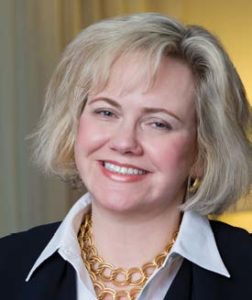Making the Leap to Better Healthcare Outcomes with Leah Binder ’80
Imagine arriving at your auto repair shop only to discover that technicians have accidentally replaced the oil in your car with water and have destroyed the engine. “The shop owner doesn’t go on to say, ‘And here is a bill for the water and a new engine,’” says Leah Binder. “But this happens every day in the healthcare industry. Unsafe hospitals bill employers and government for fixing the consequences of errors, with little or no financial sting.”
 Binder is president and CEO of the Leapfrog Group, a Washington-based nonprofit organization. Leapfrog launched operations in 2000 after executives from some of the country’s largest corporations gathered to address a simple question: Why were their products and services held up to market scrutiny when the hospitals that provided care to their employees were not?
Binder is president and CEO of the Leapfrog Group, a Washington-based nonprofit organization. Leapfrog launched operations in 2000 after executives from some of the country’s largest corporations gathered to address a simple question: Why were their products and services held up to market scrutiny when the hospitals that provided care to their employees were not?
The costs are significant, with many U.S. businesses paying out more for employee health coverage than they earn in profits. While executives and shareholders want to ensure an acceptable return on healthcare spending, the human toll is more troubling: close to 1,000 Americans die in hospitals every day from preventable errors. “Until recently, there were minimal financial consequences for an unsafe hospital,” says Binder, who joined Leapfrog in 2008. She estimates that up to one-third of healthcare spending is wasted on unnecessary procedures, administrative costs, medical errors—and even fraud.
Increasing transparency
Leapfrog’s initial objective was to improve transparency by creating a national hospital performance report card that employers and employees could use to make informed decisions. Every year, the organization asks the country’s 4,000 hospitals to respond to the web-based Leapfrog Hospital Survey. Leapfrog compiles the collected data on safety, quality, and resource use—in areas from maternity care and surgical outcomes to handwashing policies and nursing standards—and publicly reports the results by hospital. National and regional health plans use the survey results to create decision-making tools for their members while regional coalitions use the data to move safety and quality initiatives forward.
Not all hospitals complete and submit the voluntary survey. But as the number of responding institutions has increased to more than 1,800— representing 60 percent of hospital beds in the country—non-responding hospitals have experienced pressure to make their safety records more transparent. Binder recounts tales of healthcare executives who tell her that one of their primary objectives is to earn an “A” rating from Leapfrog. “I also hear about uncomfortable board meetings,” she says. “Board members are cornering CEOs to say, ‘We don’t understand—for years, you’ve been showing us stellar safety reports, but we get a C from Leapfrog? Why?’”
Binder says that her Waynflete teachers were the first to encourage her to pursue math and science and not be intimidated by data and statistics. Of her Waynflete education, she says, “It changed the game for me. For the first time I began to look at myself seriously as a student. It opened my eyes to a whole new opportunity. Waynflete jolted me into a broader view of what I could do.”
Leveraging consumer-focused tools
During her tenure, Binder has driven the organization to develop consumer-focused tools such as the Leapfrog Hospital Safety Grade. Launched in 2012, the Hospital Safety Grade uses publicly available data from the Centers for Medicare & Medicaid Services. Unlike the hospital survey process, Leapfrog conducts its data analysis and then assigns a letter grade to each hospital, irrespective of whether the institution responds to the Hospital Survey.
The Hospital Safety Grade captures significant media attention when it is released annually. “We have the dream team of national patient safety experts, so it’s not surprising that people are interested,” says Binder. “The safety grade each hospital receives helps consumers understand the dangers.” Consumer Reports and U.S. News and World Report release their own findings, but since these publications examine different aspects of hospital performance, Binder considers the research to be complementary. “Consumers want as much information as possible,” she says. “We’re used to shopping online for everything today, and we like to see as many reviews as possible.”
Binder, who was recently named to Modern Healthcare’s list of the “100 Most Influential People in Healthcare,” doesn’t doubt that hospital administrators have good intentions. “It’s just that no one has been able to hold them publicly accountable for their hospital’s performance because we didn’t have the data. They simply didn’t have to worry about the financial impact of catastrophic mistakes. Leapfrog is changing that landscape.”



